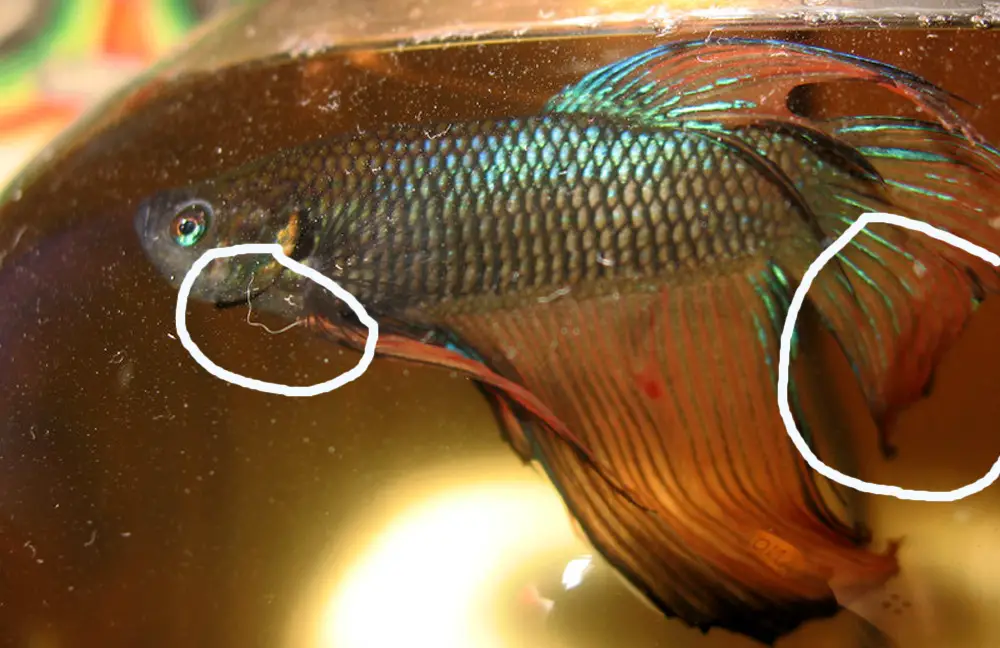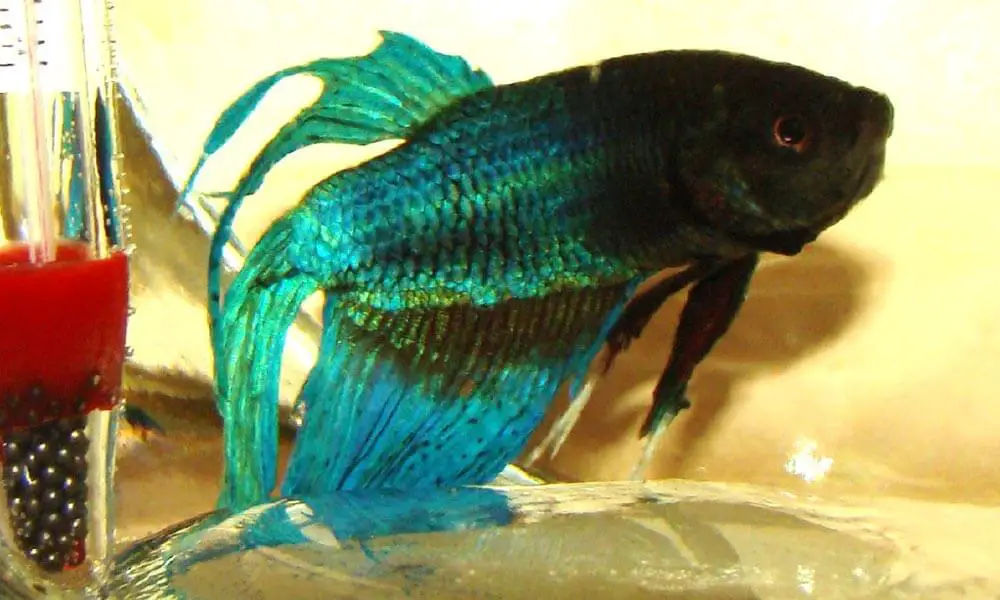If you are planning to own betta fish, understand now why it is so important to take fin rot seriously. This is one of the most unfortunate conditions which can befall your betta fish. While fin rot can be devastating to many different types of aquarium fish, it is considered to be more prevalent among bettas.
The more you learn about fin rot symptoms and causes, particularly among betta fish, the easier it will be to appreciate just how grave this condition can become. One of the most important things to remember about fin rot is the fact that time is of the essence, when it comes to how you respond.
We’re going to cover betta fish fin rot treatments shortly. For now, let’s start with a deep dive into everything you need to know about betta rot.
What Is Fin Rot?
Let’s start our discussion of fin rot in betta fish with some good news: Yes, fin rot is treatable, and the success rate, when you keep in mind all the steps and tips involved, is quite high. However, you need to understand what you’re dealing with.
Ideally, you’ll get all of this information before bringing your betta home. If that isn’t the case, relax. While fin rot can be absolutely brutal, betta fish retain their reputation for toughness. There is a reasonable window between detection and successful treatment.
Fin rot is essentially the consequence of too much bacteria in an aquarium. Obviously, we need a certain number of bacteria present to break things down and so forth. At the same time, too much bacteria can be problematic. The stress it can put on your fish, especially the bettas, can lead to things like fin rot.
It is commonly thought of as a bacterial infection. This is true, but that doesn’t tell the whole story.

The Truth About The Origins Fin Rot
As it turns out, fin rot can be bacterial or fungal. These are two considerably different things, so it becomes crucial to be able to tell the difference between them. When you can do this, your treatment will have higher odds of being effective.
The type of fin rot you are dealing with is perhaps best understood by looking at the evenness of the damage. Fin rot causes physical wear and tear to the fins and other areas of your bettas. We will cover this in greater detail later. For now, just keep in mind that bacterial fin rot causes your bettas to look uneven. A fungal case of fin rot can be indicated by damage that looks more even.
What Causes Betta Fish Fin Rot?
We have already briefly touched on the basic conditions that can lead to fin rot. As previously indicated, it is most commonly brought about due to unsanitary conditions in your tank. Don’t forget that even if you have one of the best aquarium filters on the market, you should still be cleaning out your tank on a regular basis. This means removing a certain percentage of the water in the tank (a minimum of 10%), as well as removing debris and untouched foodstuffs along your tank’s bottom.
The temperature of your tank, the number of fish in your tank, and even the size of your tank can all play a role in creating the conditions necessary for fin rot to occur. While fin rot in of itself is not the end of the world, it is often made much worse with the addition of stress. What does this mean?
The Relationship Between Stress And Immune Systems In Bettas
While it is obviously important to take fin rot seriously, it is just as important to see why fin rot is so problematic in the first place. It comes down to the issue of stress, and what that means for the immune system of your bettas.
Bettas are hardy fish for your aquarium. Unfortunately, they can be prone to stress. This stress can come from overcrowded conditions, the tank not being the ideal temperature for betta fish, bullying by other fish, and more. Females are particularly susceptible to stress from over-eager males and even other females.
When you stress your betta out, the same thing happens to him as happens to any of us when we’re way too anxious: The immune system tanks. This make us more susceptible to getting sick. This applies to bettas, and it can be realized in a variety of different ways. Not only can your betta be more likely to contract fin rot when it’s stressed out, but the stress and weakened immune system can make fin rot much more serious.
So, if we want to prevent fin rot, we have to keep conditions ideal for your betta on every possible level. Otherwise, it will not be long, before you start to see symptoms.
Symptoms Of Fin Rot In Bettas
Another point worth repeating: Time is definitely off the essence, when it comes to treating your bettas for fin rot. We cannot overstate the value of knowing exactly what to look for, when it comes to signs that your betta fish has fin rot.
Here are the most significant fin rot symptoms to keep in mind. Because it is important to be as specific as possible, when it comes to knowing what to look for with fin rot and bettas, we’re going to break things down into mild fin rot symptoms and serious fin rot symptoms.
Mild Betta Fish Fin Rot Symptoms
Obviously, the main benefit of being able to identify these milder symptoms is the chance to treat and prevent future outbreaks much more successfully:
- Look for a slight darkness to the fins of your betta. In general, good betta maintenance will include being aware of what your bettas fins normally look like.
- Pay attention to the tips, as well. If you suddenly notice the presence of brown, grey, or white colors in this area, there is a good chance that your betta has a mild case. The tips can also look irritated, with a sore appearance.
- One of the most notorious symptoms of fin rot relates to the ragged edges that suddenly appear along the fins of your betta. The area can also look frayed, damaged (as though attacked). Check your bettas regularly to know when this symptom might be appearing.
If your betta’s case of fin rot is only mild, there should not be any indication of rot anywhere NEAR the body of the betta. This is far and away the most important distinction between mild and major fin rot.
Serious Betta Fish Fin Rot Symptoms
Remember the window of opportunity that rests between identifying fin rot and successful treatment? It is mostly open to the criteria of mild fin rot.
If your betta has a more serious case, the window closes to a noticeable degree. While successfully restoring a betta with serious or major fin rot is not impossible, it does become a good deal more difficult at this juncture.
Here are the most common signs of a serious, possibly deadly, case of fin rot for your betta:
- The placement of the fins is once again very important in this arena. If your betta is fighting a bad case of fin rot, you will immediately see the fins receding towards the body to a highly dangerous degree.
- Rather than a slow-but-steady change in color and appearance, serious fin rot cases will be highlighted by entire clumps of your betta’s fin simply falling away.
- An actual, significant portion of the fin will be completely dead. This can be as much as 1.5cm.
- Recall the light discoloration we discussed earlier with the milder symptoms. If the condition has progressed to a potentially critical point, this discoloration will be impossible to ignore. Look for something that is going to be extremely dark in appearance.
- Do you see white fuzz anywhere on the betta’s fin? This is another guarantee that your betta is dealing with the worst possible version of the infection.
- In addition to the white fuzz, you should also be able to see the presence of red spots all over the betta.
Again, treatment is not impossible at this point. Just understand that the odds are also rather stacked against you. Nursing your betta back from this point is extremely time-consuming, and it will not come with any assurances that the betta will recover. This is why we want you to be able to catch these symptoms as early on as possible.
Next, let’s discuss treatment and prevention.
Betta Fin Rot Treatment
While there are indeed treatment options, which we will discuss in greater detail shortly, prevention is really the best way to deal with fin rot, regardless of the specific fish you own. Prevention means implementing simple steps that will ultimately make your betta and other tank mates of your aquarium family as happy as possible.
Having said that, there are a few things you will want to consider, when it comes to fin rot treatments for bettas.
The Best Betta Fin Rot Medicine in Betta Fish?
The first thing we should talk about is the subject of quarantine.
Should you isolate any and all fish, including your betta, which are confirmed to have fin rot? Yes. If your tank is larger than two gallons, or if you have any other living beings or plant life, you should cut off the infected betta from your actual aquarium as soon as possible.
Setting up a quarantine betta fish tank is pretty much the same as setting up a normal fish tank. Add your conditioned water heater, and filter. Make sure, even with a filter, you’re changing out the water in the tank every couple of days.
Also: If you want to minimize the stress your betta might experience from being moved to a new tank, put them in the new tank in a tied-off plastic bag, filled with the water of the original tank. After about 15 minutes of floating along the top, they should be just fine. Let them out, and keep a very close eye on them.
Once the betta has been isolated, make them as comfortable and happy as possible. Your next measure will be to seek out and use an effective antibiotic.
For more information on treatment products for infections such as fin rot, check out the following aquarium fish treatment medications that you can purchase at Amazon and elsewhere.
Regardless of where you decide to put your sick betta, make sure the tank conditions are always ideal. This means a temperature between 76 and 80F, with the pH being somewhere in the close vicinity of 7. The standards your specific betta is used to is going to ultimately be your best bet.
There is also some serious potential to be considered in using aquarium salt as a means of treating fin rot. If used sparingly and gently, aquarium salt can prove to be enormously effective.
Just keep in mind that you do not want to use this product for more than ten consecutive days. Follow the directions for any product you purchase very carefully. Failing to do this can lead to even more health problems for your bettas, including kidney damage and liver damage.
How To Prevent Fin Rot in Bettas?
Let’s see what we can accomplish in the way of prevention:
A Clean Betta Tank
This is worth mentioning at least one more time! A tank that is being cleaned on a regular basis, combined with the use of a filter and other conditions agreeable to bettas, is a tank that your betta fish will love. This diminishes stress, while keeping the potential for bacteria to build up and cause problems low.
The Right Size Tank
Your bettas need the right size tank to be happy, as well. Five gallons is considered to be the absolute minimum. If you plan to have several fish, or if they’re going to share space with other types, the tank should be bigger.
The Right Number of Fish
Overcrowding creates stress, but it also creates heightened conditions for something like fin rot to thrive. In a five-gallon tank, there shouldn’t be more than four or five fish, but even that is kind of pushing it.
Figure out if your tank meets the conditions for problematic or even dangerous overcrowding. If that proves to be the case, it might be time to invest in a second aquarium.
Males and Females Bettas
Male bettas and female bettas can live together. However, there are several things within this thought to keep in mind. Otherwise, you can wind up creating highly stressful conditions for the bettas in your tank.
Act Fast
Prevention also involves preventing a mild case of fin rot from becoming something much graver. Remember the symptoms of mild fin rot we mentioned above. This isn’t something that needs to consume your life, but giving your betta a close look at least once a day can protect them from so much.
FAQ
Let’s summarize everything we’ve covered here today with a few of the most common questions and answers concerning betta fin rot:
Should I automatically panic, as soon as I see that my betta has fin rot?
Certainly not. You have to remember that this infection is extremely common, Meaning the odds are pretty good that your betta is going to have it at one point or another. As long as you can spot the condition early enough, there is almost certainly nothing to seriously worry about.
Is one fin rot treatment method more effective than the other?
Not really. We wouldn’t suggest trying both aquarium salt and antibiotics at the same time, but each have their own solid respective track orders. We would suggest starting out with one of the antibiotics mentioned above. This should be combined with creating the best possible conditions in your tank.
Do I really need to isolate my betta from the rest of my fish?
We would strongly advise it. One of the easiest ways for fin rot to pass is for one fish to give it another fish. This can be done more quickly and easily than you might think. If you know in no uncertain terms that your betta has fin rot, they should be cut off from the others ASAP. It is also a good idea to keep as close an eye on the rest of your fish as possible.
What can I do to further aid in the recovery of my betta?
There are actually a couple of very helpful things you can do. In the first place, remove anything from the tank that might cause damage to the highly delicate condition your betta will be in while on the mend. You should also make it a point to keep your patient away from other fish, until the point in which it has healed completely.
Can my betta get fin rot twice?
Yes.
Conclusion
With this comprehensive guide, it should be easy to give your betta the very best of care.






